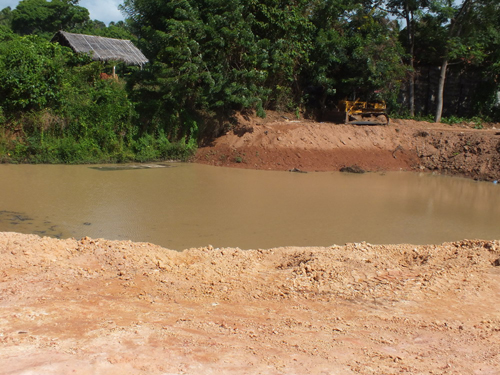Idling tippers and workers
View(s):
Sand mining
Wasana is a busy service-provider in his thirties, who is always “on call”. He gets phone calls from the sand-traders in the Baddegama area. He is an experienced and efficient worker in providing his service, which is hard work that cannot be done by everybody – loading the tippers with sand using a shovel. When a tipper has to be loaded, he is notified with a phone call; within a couple of minutes he arrives at the site on his scooter and starts loading the tipper.
For Wasana, it takes only 20 – 25 minutes to fill a tipper up to the brim – as everyone calls it, “one cubic” of sand, even though technically cubic is a different measure. His fee is Rs. 300 for filling one tipper. Before the COVID-19 pandemic hit the economy, he used to earn on average about Rs. 4,500 a day by loading 15 tippers. He didn’t have 8-hour work schedules, but his working time is constrained by the time tippers start coming to buy sand. And neither has he free weekends or other holidays as he is “on call” for all 365 days of the year. He didn’t have a particular working place either; however, he was available for work in a couple of sand-trading sites in the area.
One of the income groups hit hard by the COVID-19 pandemic was daily income-earners like Wasana. He is still “on-call” eagerly waiting for calls for his job. But the work is rare now and he gets no more than 2 – 3 tippers to load a day; as a result, his daily income has gone down to less than Rs. 1,000, and he is often idling, waiting for a call.
Sand-trading site
One of the sand-trading sites that Wasana used to work belongs to Pemasiri – a leading sand supplier in Baddegama. He used to send his own tippers to sand-mining sites in Hambantota – these are big tippers which can be loaded with “three and half cubic” sand. In the sand-mining areas, earth is cut, washed and cleaned in order to get pure sand as a building material; it is done with machinery. Then, pure sand is sold to the traders like Pemasiri; he transports it to his own sand-trading site in Baddegama.
Before the pandemic issue, about 3 – 4 big tippers loaded with sand used to arrive every day and unload in Pemasiri’s sand-trading site. It can be loaded into 10 – 15 “one cubic” tippers with the service rendered by workers like Wasana. The whole load of 3 – 4 big tippers was estimated to be roughly the daily demand for sand at Pemasiri’s site; they all were busy in meeting that demand on the same day, because the next day was going to be the same! If there is a delay anywhere in this supply chain, he was going to lose business as he was not the only sand-supplier in the area. It was a competitive market because customers have a wide range of choices with a couple of sand-trading sites within close proximity.
The pandemic has affected the construction work and thus the demand for sand too has fallen sharply. Even one “three and a half cubic” load becomes too big to meet daily demand; as a result, the tipper loads arriving were cut down to about 3 – 4 tippers a week. While the tippers remain most of the time idling, the tipper drivers lost their work and their daily income of Rs. 3,000 that they earned earlier. Most of the time of the week, they also have to stay at home now without reporting to work.
Construction industry
At the same time, the activities at the sand-mining site in Hambantota too got paralysed; as tippers do not come to take sand and the miners have to reduce their business activity. The machines are now under-utilised and most of the workers were sent back home. They too lost their work and daily incomes.
Sand is an essential material in the construction industry which goes into buildings, houses and, infrastructure work together with other materials, parts and components such as cement, bricks, metal, wood, plastic, aluminum, and tubes; if they are buildings and houses, they also require floor tiles, wall tiles, roof tiles, granite surfaces, railings, electrical fittings, ceramic fittings and so on. The suppliers of all these materials, parts and components should now slow down their production just like what has happened to the sand supply. Together with all that, the workers of all types – masons, plumbers, electricians, carpenters, drivers, designers, architects, engineers, and labourers – they all lose both their work and income.
 There is another layer of losses. As businessmen and workers both encountered loss of their incomes, they all have to cut down their spending too. While Pemasiri had the problems of paying off his own bank loan instalment, he had signed as a guarantee for bank loans of his colleagues; hit by the same type of problems, they have now defaulted, putting Pemasiri in trouble with the banks. One of his tippers need repair for which he has to spend a few hundred thousand; as he keeps postponing it, his mechanic has also lost his work and due income.
There is another layer of losses. As businessmen and workers both encountered loss of their incomes, they all have to cut down their spending too. While Pemasiri had the problems of paying off his own bank loan instalment, he had signed as a guarantee for bank loans of his colleagues; hit by the same type of problems, they have now defaulted, putting Pemasiri in trouble with the banks. One of his tippers need repair for which he has to spend a few hundred thousand; as he keeps postponing it, his mechanic has also lost his work and due income.
Wasana and all the workers connected to Pemasiri’s business and all other construction related businesses had their own share of problems of managing their monthly expenses. They all have to cut down their monthly expenses for consumption – food, clothing, transport, medicines, and so on, their production would fall too, resulting in loss of work and income.
Economy
What happens to an economic activity such as sand-trading or its owner such as Pemasiri or its workers such as Wasana happens the same way to the entire economy as well. All economic activities emanating from agricultural or industrial or services activities, are all aggregated into a single number called gross domestic production (GDP). It can be used to construct many different indicators of economic progress as well as loss of a country.
According to the Central Bank’s Annual Report 2020, the COVID-19 pandemic has wiped out Rs. 353 billion of Sri Lanka’s GDP in real terms; in other words, the economy has contracted by 3.6 percent last year. At sectoral level, the agriculture sector has contracted by 2.4 percent, industrial sector by 6.9 percent and, services sector by 1.5 percent. Construction industry, which is part of the industrial sector which contributes over 6 percent to GDP has reported the biggest contraction of 13.2 percent.
In other words, the loss of GDP is a loss of “work” in every sector – agriculture, industry and services, so that it reduces income too; Sri Lanka’s per capita income in US dollar terms has declined to $3,582 from $3,741 in the previous year, 2019 by $159. The government’s tax revenue was Rs. 1735 billion in 2019, which was lost by Rs. 520 billion in 2020 widening the budget deficit and, thereby more borrowings.
Part of the GDP is for export sales, while GDP and exports usually fall together as well as they grow together. Exports fell from $12 billion to $10 billion, a drop of $2 billion, exerting pressure on the exchange rate,
foreign debt payments and, foreign exchange reserves.
Beneficiaries
One of the economic activities that benefited from the pandemic crisis was the “information and communication” sector, which has grown by 13.7 percent in 2020. It’s not surprising that some of the activities get a boost under different circumstances. Furthermore, tightened import controls have affected the overall economy, but some of the individual businesses started enjoying a gala time; they could raise their monopoly prices in the absence of competition in the protected market.
However, it doesn’t mean that we must appreciate the spread of the pandemic which has given a boost to the information and communication sector or promote import controls to lift a few business activities. The reason is obvious – the magnitude of losses would outweigh the benefit.
(The writer is a Professor of Economics at the University of Colombo and can be reached at sirimal@econ.cmb.ac.lk and follow on Twitter @SirimalAshoka).


